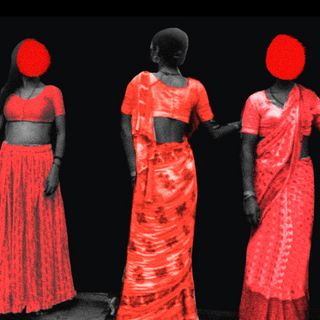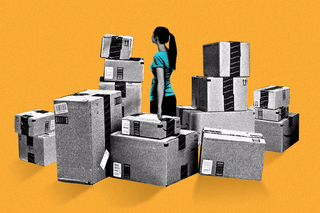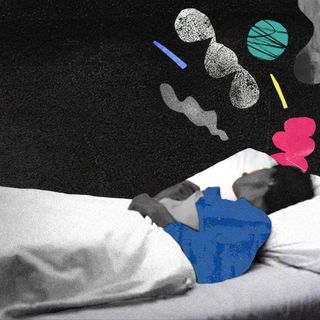
The Glamorization of ‘Retail Therapy’ Prevents Us From Recognizing Shopping Addiction as a Serious Problem
Trivializing compulsive shopping as a vanity-driven, leisure activity can prevent people from seeking help for a potentially destructive addiction.

When we shop for new clothes, home decor, art supplies, gadgets, what have you, every once in a while, our brains perceive it as a reward and release the “feel good” hormone, dopamine, that triggers a rush and immediately uplifts our moods. This is precisely why shopping is often called “retail therapy.” But this trick to achieve a quick, easy respite from the doom and gloom of life on particularly dull, depressing days can quickly become a compulsive behavior – ultimately costing people a lot more than they bargained for. Literally.
In the digital age, hassle-free access to online shopping around the clock can make it even more difficult to resist impulses, propelling people down destructive spirals with just a few clicks. “The first few days, I didn’t see any harm in scrolling through shopping apps, but things started going wrong very quickly… I started ordering unnecessary things, my balances were running out, and there even came a point when I was simultaneously shopping in-store, too,” says Nayanita, 22. “I knew it was getting uncontrollable, but I couldn’t help myself.”
A multi-nation study from 2015 found that one in 20 people may struggle with a shopping addiction. With reports of declining mental health in the aftermath of the pandemic, these numbers are, in all likelihood, significantly worse. Carrie Rattle, a financial therapist and coach, reports a “dramatic increase” in compulsive shoppers approaching her for help since March 2020. “When you have a life-changing event like Covid19, there’s fear, no control, uncertainty… l of these emotions are so extreme that you need to be able to cope somehow. So [for] people who sort of enjoyed shopping before as a happy thing, now it was their escape mechanism.”
Yet, the impact of compulsive shopping on people’s lives is easily downplayed. Rattle calls it a “smiled-upon addiction” that is almost celebrated due to its glamor quotient. “Some people mistake a shopping addiction for a luxury pastime only for the rich. The act of compulsively shopping is an overwhelming condition that can bankrupt any person’s emotional life and their family’s finances,” states an article.
Acknowledging the mental health impact of the addiction, Rattle notes that most of the people who come to her seeking help, aren’t prompted by financial crunches but driven, instead, by debilitating feelings of guilt and shame, both of which can become a perennial presence in their lives. Aditi, 28, experienced this too. Ashamed of her behavior, she actively concealed her addiction to shopping from everyone, including her mother, who she had been staying with, “The orders would arrive during the day, and I would hide it all [before my mother got home].”
Related on The Swaddle:
For People With Poor Impulse Control, Instant Food Delivery Apps Can Kickstart Disordered Eating
Shopping addiction isn’t just trivialized but also the “most socially reinforced” behavioral addiction. According to the Recovery Trust, a non-profit rehabilitation alliance in the U.K., “The stigma attached to excessive drug or alcohol use in modern society doesn’t apply to compulsive shopping habits, with a consumerist lifestyle perceived as a measure of social status… exacerbating the problem for many.”
More than vanity or a materialistic craving, Hetal, 22, was consumed by the compulsive urge to shop while attempting to recover from an eating disorder. But opening up to her friends about her struggles only led to mocking comments about how she never saves money and jokes like, “Do you ever stop shopping?” Further, she says, “When people continued dismissing it, I did too,” adding that she began to internalize people’s opinions on her compulsive behavior – instead of seeking help or even just looking up compulsive shopping online.
The razzle-dazzle of the consumerist culture we live in, obscures the internal struggles of compulsive shoppers like Hetal to onlookers, who saw her as a “spoilt brat” or a “big spender,” implying she was in control and, therefore, denying her any compassion. Invalidation, coupled with derision and value judgments, forms the core of society’s reactions to shopping addictions, discouraging people from seeking help. This is also, perhaps, why Hetal has never come across another person who shares her struggles despite statistics pointing to the sheer number of people who compulsively shop.
Psychotherapist Zohra Master, an associate fellow, and supervisor from the Albert Ellis Institute, explains that belittling compulsive behavior also invalidates the underlying distress – like grief, anhedonia, existential vacuum – triggering the behavior. For Aditi, it was her struggle to process the grief of her father’s sudden death while being forced to go through the rigmarole of everyday life that led her down the path of developing the addiction. Metaphorically, then, if a shopping addiction connotes a cry for help, its glamorization ensures the cry goes unheard.
Raksha, 24, was advised by her therapist to simply set a budget for herself to deal with her compulsive urge to shop. But since it didn’t address – or even investigate – the underlying issues driving her behavior, the tactic didn’t work. “What might help deter a compulsive shopper more than being teased – or even told to simply be more cautious about spending – is people around them trying to understand what the fundamental issue is that is propelling them to indulge in compulsive shopping,” says Master.
Related on The Swaddle:
Drinking Coffee Before Shopping Is a Bad Idea – It Leads to Impulse Buying
Pop culture is also replete with overt promotions of consumerism; TV shows like Sex And The City, movies like Student of The Year, and music videos like Jass Manak’s Shopping, all make compulsive shopping seem like a glamorous pursuit.
On the surface, Confessions of a Shopaholic seems like a relativelybetter depiction of just how destructive this “glamorous” addiction can be — with the film’s protagonist, Rebecca Bloomwood, eventually losing her best friend, her job, and every penny she ever earned. But through warm-tinted color palettes, animated mannequins in pretty dresses, the lack of long-term consequences, and the villainizing of Derek Smeath — her debt collector and the only consistent representation of the ugly side of Bloomwood’s addiction — Confessions, too, ends up romanticizing the struggle of dealing with a shopping addiction. Instead of delving into the “why” behind her addiction – or even the guilt that would ideally follow — the movie plays the protagonist’s predicament for laughs, trivializing it yet again.
Even though compulsive shopping can affect people of all genders, the fact that shopping is perceived as a womanly activity makes it easier for society to trivialize it — much like women’s pain has remained both underestimated and under-researched throughout history. “Right up to the present day we have a culture tacitly or overtly encouraging women to shop in order to strengthen the economy. At the same time, we’ve always had male commentators denigrating women for their love of trinkets and their wasteful expenditures,” Rebecca Connor an associate professor of English at Stanford University, told The New York Times.
This is capitalist agenda at its finest: retail therapy is promoted as a coping mechanism, almost to bait-and-switch consumers; at the same time, compulsive shopping, the calamitous ramification of such messaging, is blamed on poor impulse control, bad lifestyle choices, or vanity. In the process, corporations can make money off people’s misery without bearing any responsibility for their impact.
Unfortunately, society’s unwillingness to see compulsive shopping as a “real” problem, births a vicious cycle — people struggle with addiction while never addressing the demons that initially led them to seek solace in shopping, flaming their addiction further, in the process.
Devrupa Rakshit is an Associate Editor at The Swaddle. She is a lawyer by education, a poet by accident, a painter by shaukh, and autistic by birth. You can find her on Instagram @devruparakshit.
Related


Nightmares Could Signal Future Risk of Dementia, Research Shows
